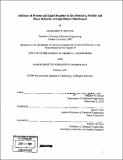| dc.contributor.advisor | Alice P. Gast. | en_US |
| dc.contributor.author | Horton, Margaret R. (Margaret Ruth) | en_US |
| dc.contributor.other | Massachusetts Institute of Technology. Dept. of Chemical Engineering. | en_US |
| dc.date.accessioned | 2007-09-28T13:25:59Z | |
| dc.date.available | 2007-09-28T13:25:59Z | |
| dc.date.copyright | 2006 | en_US |
| dc.date.issued | 2007 | en_US |
| dc.identifier.uri | http://hdl.handle.net/1721.1/38982 | |
| dc.description | Thesis (Ph. D.)--Massachusetts Institute of Technology, Dept. of Chemical Engineering, February 2007. | en_US |
| dc.description | Includes bibliographical references (p. 136-148). | en_US |
| dc.description.abstract | The lipid bilayer forms the basic structure of the cell membrane, which is a heterogeneous matrix of proteins and lipids that provides a barrier between the interior of a cell and its outside environment. Protein and lipid domains in cell membranes can facilitate receptor localization, stabilize membranes, and influence membrane fluidity. In this thesis, we study how ordered protein and lipid domains influence the physical properties of lipid bilayers to better understand the roles of membrane domains in biological mechanisms. Model cellular membranes that mimic the behavior of biological membranes offer a controllable environment for systematically studying the isolated effects of protein and lipid ordering on membrane organization. Using fluid and solid-supported lipid bilayers, we study ordered peripheral membrane proteins and lateral lipid phase separation with fluorescence microscopy and X-ray reflectivity. To model cellular protein coatings and peripheral proteins, we prepare biotin-functionalized membranes that bind the proteins streptavidin and avidin. Fluorescence microscopy studies demonstrate that proteins crystallized in a single layer on lipid bilayer surfaces can change the lipid curvature and stabilize lipid vesicles against osmotic collapse. | en_US |
| dc.description.abstract | (cont.) At solid interfaces, we characterize the electron density profiles of protein-coated bilayers to determine how a water layer separates an immobile protein layer from the fluid lipid bilayer. Liquid-ordered lipid phases enriched in cholesterol and sphingomyelin can localize molecules in cell membranes and this lipid phase separation behavior may be influenced by proteins and molecules in the membrane. Caveolae are specialized liquid-ordered domains in the plasma membrane that are enriched in the protein caveolin-1. We demonstrate that caveolin-1 peptides influence the onset of lipid phase separation and bind phase-separated lipid bilayers in solution. On solid surfaces, the formation of liquid-ordered lipid phases is influenced by surface roughness; with reflectivity, we determine that lipid bilayers containing cholesterol and sphingomyelin thicken with increasing cholesterol content. The membrane receptor GM1 also thickens the lipid bilayer when it is incorporated into the bilayer upper leaflet. The diverse experimental platforms that we present are applicable to studying additional and more complex biological systems to elucidate the influence of lipid and protein domains on cell membrane structure, organization and fluidity. | en_US |
| dc.description.statementofresponsibility | by Margaret R. Horton. | en_US |
| dc.format.extent | 148 p. | en_US |
| dc.language.iso | eng | en_US |
| dc.publisher | Massachusetts Institute of Technology | en_US |
| dc.rights | M.I.T. theses are protected by copyright. They may be viewed from this source for any purpose, but reproduction or distribution in any format is prohibited without written permission. See provided URL for inquiries about permission. | en_US |
| dc.rights.uri | http://dspace.mit.edu/handle/1721.1/7582 | |
| dc.subject | Chemical Engineering. | en_US |
| dc.title | Influence of protein and lipid domains on the structure, fluidity and phase behavior of lipid bilayer membranes | en_US |
| dc.type | Thesis | en_US |
| dc.description.degree | Ph.D. | en_US |
| dc.contributor.department | Massachusetts Institute of Technology. Department of Chemical Engineering | |
| dc.identifier.oclc | 166351561 | en_US |
